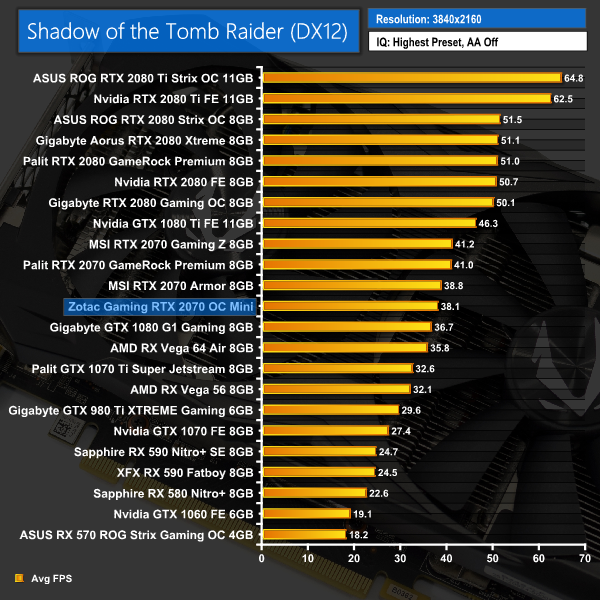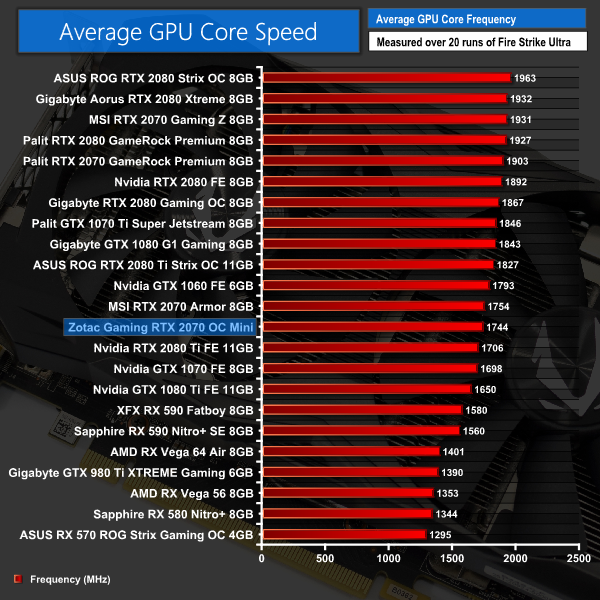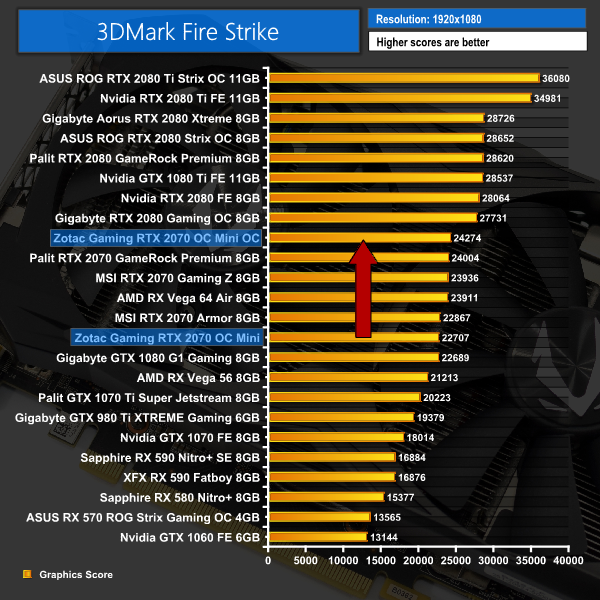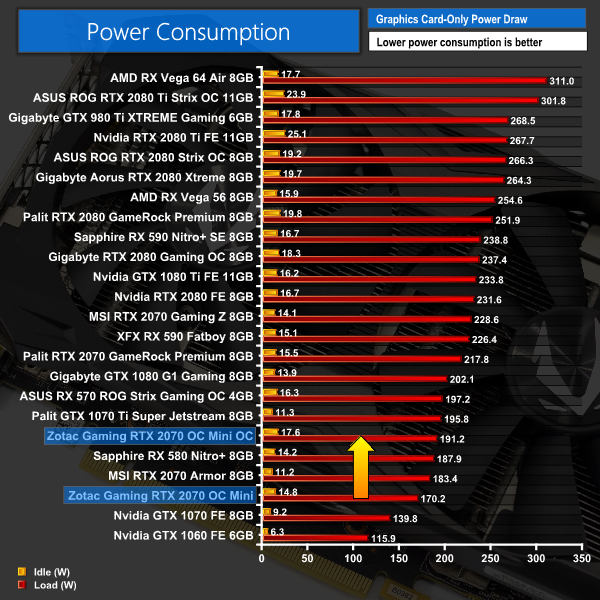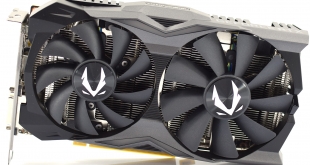
Zotac is well known for producing monster-sized graphics cards within its AMP! Extreme line up, but then it has also had success at the opposite end of the spectrum with its Mini series. The card we are looking at today is definitely Mini, measuring in at just 211mm long. It's an RTX 2070, too, with a factory overclocked core – so we are definitely still hoping for solid performance despite this card's diminutive nature. Have any trade-offs been made to get an RTX 2070 to this size? Let's find out.
Interestingly, Zotac has released two versions of its RTX 2070 Mini card – one ‘OC' model with a 1650MHz boost clock, and one reference-clocked model with a 1620MHz boost clock. The former retails for £539 while the latter is currently a fair bit cheaper at £459. We have the OC model in for review, so let's see how it stacks up against the competition.
| GPU | RTX 2080 Ti (FE) | GTX 1080 Ti | RTX 2080 (FE) | GTX 1080 | RTX 2070 (FE) | GTX 1070 |
| SMs | 68 | 28 | 46 | 20 | 36 | 15 |
| CUDA Cores | 4352 | 3584 | 2944 | 2560 | 2304 | 1920 |
| Tensor Cores | 544 | N/A | 368 | N/A | 288 | N/A |
| Tensor FLOPS | 114 | N/A | 85 | N/A | 63 | N/A |
| RT Cores | 68 | N/A | 46 | N/A | 36 | N/A |
| Texture Units | 272 | 224 | 184 | N/A | 144 | 120 |
| ROPs | 88 | 88 | 64 | 64 | 64 | 64 |
| Rays Cast | 10 Giga Rays/sec | 1.1 Giga Rays/sec | 8 Giga Rays/sec | 0.877 Giga Rays/sec | 6 Giga Rays/sec | 0.65 Giga Rays/sec |
| RTX Performance | 87 Trillion RTX-OPS | 11.3 Trillion RTX-OPS | 60 Trillion RTX-OPS | 8.9 Trillion RTX-OPS | 45 Trillion RTX-OPS | 6.5 Trillion RTX-OPS |
| GPU Boost Clock | 1635 MHz | 1582 MHz | 1800 MHz | 1733 MHz | 1710 MHz | 1683 MHz |
| Memory Clock | 14 Gbps | 11 Gbps | 14 Gbps | 10 Gbps | 14 Gbps | 8 Gbps |
| Total Video Memory | 11GB GDDR6 | 11GB GDDR5X | 8GB GDDR6 | 8GB GDDR5X | 8GB GDDR6 | 8GB GDDR5 |
| Memory Interface | 352-bit | 352-bit | 256-bit | 256-bit | 256-bit | 256-bit |
| Memory Bandwidth | 616 GB/sec | 484 GB/sec | 448 GB/sec | 320 GB/sec | 448 GB/sec | 256 GB/sec |
| TDP | 260W | 250W | 225W | 180W | 185W | 150W |
As mentioned, this is the OC Mini we are taking a look at today, so it ships with a 1650MHz boost clock – just 30MHz faster than reference, this is probably the smallest factory overclock I have ever seen. Memory has been left at stock, though, meaning we are left with the default 14Gbps speed.

The Zotac Gaming RTX 2070 OC Mini ships in a mostly grey box, with some kind of an interesting geometric design going on on the front, though there is no image of the card itself visible.
Inside, we get very little in the way of accessories – just a quick installation guide and a small note about using the latest drivers come included in the box.
The card itself is what we are here for, though, and overall I have to say it is pretty good looking, though nothing special. The plastic shroud is a combination of gunmetal grey and black which won't cause any issues in a colour coordinated build, but I do have to say the shroud itself does feel a bit flimsy and you can feel it bend and move when you pick the card up.
Two fans occupy the bulk of the front of the card, and you can see they are both different sizes and different blade designs. The fan on the left measures 90mm and has a swept blade design, whereas the fan on the right measures 100mm and has a straighter, flatter blade design. We asked Zotac about the reasoning behind this, and at the time of publication we are still waiting for an official response, but my guess is that the different fans are each designed to give slightly different air pressure levels to aid cooling of the GPU core, VRMs and memory chips as well as potentially reduce air turbulence.
Now, in terms of dimensions, this is obviously a very small card – it measures 211mm x 129mm x 41mm. That makes it the smallest RTX card I have reviewed by far, and I think you would be very hard pressed to find a case that this doesn't fit in – it's not only very short, but its thickness makes it a standard 2-slot card, instead of the 2.5 or even 2.7 slot cards we are used to seeing.
Above you can see also see two pictures of the Zotac Mini compared to the Palit RTX 2070 GameRock Premium to really highlight this size difference – both are 2070s, yet one is a very short and dinky 2-slot card, while the other is almost 30cm long and effectively a triple-slot card. They obviously have different target audiences, but it really does highlight the dimensions of this Zotac card.
To get to the PCB, just 6 screws need to be removed from the back of the card. The first thing to note is that the PCB isn't even as long as the shroud/backplate – according to my measurements, the PCB itself is 187mm long, with the extra 24mm-or so of space taken up by the heatsink and backplate design.
Elsewhere, Zotac has stuck with 6+2 power phases – the same as Nvidia's Founders Edition 2070 cards, and our 8GB of GDDR6 memory comes from Micron, with the chips labelled ‘8SA77D9WCW'. The GPU die is labelled TU106-400A, signifying it is a binned chip suitable to be sold with a factory overclock – though as we mentioned, Zotac has not been very adventurous with it by adding just 30MHz to the core compared to reference speeds.
The heatsink makes use of 5 nickel-plated heatpipes, and they all look like they measure 6mm. Given the size of the card, the aluminium fin stack is not thick dense at all, and I am very interested to see how hot this card runs – but we will get to that later in the review.
The GPU die contacts with a copper coldplate, while there is a separate coldplate surrounding that for the VRAM chips, and one more for the card's MOSFETs as well. Thermal pads are used for the VRAM chips and the MOSFETs.
On the front side of the card, a small Zotac Gaming logo occupies the middle of the plastic shroud, while you can just about make out the GeForce RTX branding to the right of that. The backplate also extends downwards to meet the plastic shroud, meaning there is no gap between the shroud and the backplate.
If we look at the backplate, it is relatively simple – it appears to be made of anodised aluminium, with just a small cut-out behind the GPU core. To the left of that, ‘LIVE TO GAME' has been printed in white text, while Zotac's logo (which appears to be some kind of mask or face) takes up the right-hand side of the backplate, again printed in white.
This Zotac card is also notable as it is the first RTX 2070 card we have seen to ship with a single 8-pin PCIe power connector – all the others have used 1x 8-pin and 1x 6-pin designs.
In terms of I/O, we find 3x DisplayPorts, 1x HDMI and 1x DVI-D – but interestingly no USB-C which has quickly become standard for RTX cards.Our newest GPU test procedure has been built with the intention of benchmarking high-end graphics cards. We test at 1920×1080 (1080p), 2560×1440 (1440p), and 3840×2160 (4K UHD) resolutions.
We try to test using the DX12 API if titles offer support. This gives us an interpretation into the graphics card performance hierarchy in the present time and the near future, when DX12 becomes more prevalent. After all, graphics cards of this expense may stay in a gamer’s system for a number of product generations/years before being upgraded.
We tested the RX Vega64 and Vega56 using the ‘Turbo‘ power mode in AMD’s WattMan software. This prioritises all-out performance over power efficiency, noise output, and lower thermals.
As mentioned, this Zotac 2070 OC Mini ships with a 1650MHz boost clock – 30MHz faster than Nvidia's reference spec.
Driver Notes
- All AMD graphics cards were benchmarked with the Adrenalin 18.11.1 driver.
- Nvidia graphics cards (apart from RTX 20 series cards) were benchmarked with the Nvidia 399.24 driver.
- RTX 2080 and 2080 Ti cards were benchmarked with the Nvidia 411.63 driver.
- RTX 2070 cards were benchmarked with the Nvidia 416.33 driver.
Test System
We test using the Overclockers UK Germanium pre-built system. You can read more about it over HERE. It is important to note we have had to re-house the components to an open-air test bench to accommodate our new GPU power testing (more on that later) but the core of the system is unchanged and the performance figures you see presented here are what you can expect from the Germanium.
| CPU |
Intel Core i7-8700K
Overclocked to 4.8GHz |
| Motherboard |
ASUS ROG Strix Z370-F Gaming
|
| Memory |
Team Group Dark Hawk RGB
16GB (2x8GB) @ 3200MHz 16-18-18-38 |
| Graphics Card |
Varies
|
| System Drive |
Patriot Wildfire 240GB
|
| Games Drive | Crucial M4 512GB |
| Chassis | Streacom ST-BC1 Bench |
| CPU Cooler |
OCUK TechLabs 240mm AIO
|
| Power Supply |
SuperFlower Leadex II 850W 80Plus Gold
|
| Operating System |
Windows 10 Professional
|
Comparison Graphics Cards List
- Nvidia RTX 2080 Ti Founders Edition (FE) 11GB
- ASUS ROG RTX 2080 Ti Strix 11GB
- Nvidia RTX 2080 Founders Edition (FE) 8GB
- Gigabyte RTX 2080 Gaming OC 8GB
- Palit RTX 2080 GameRock Premium 8GB
- ASUS ROG RTX 2080 Strix OC 8GB
- Gigabyte Aorus RTX 2080 Xtreme 8GB
- MSI RTX 2070 Gaming Z 8GB
- MSI RTX 2070 Armor 8GB
- Palit RTX 2070 GameRock Premium 8GB
- Nvidia GTX 1080 Ti Founders Edition (FE) 11GB
- Gigabyte GTX 1080 G1 Gaming 8GB
- Palit GTX 1070 Ti Super Jetstream 8GB
- Nvidia GTX 1070 Founders Edition (FE) 8GB
- Nvidia GTX 1060 Founders Edition (FE) 6GB
- Gigabyte GTX 980 Ti XTREME Gaming 6GB
- AMD RX Vega 64 Air 8GB
- AMD RX Vega 56 8GB
- Sapphire RX 590 Nitro+ Special Edition (SE) 8GB
- XFX RX 590 Fatboy 8GB
- Sapphire RX 580 Nitro+ 8GB
- ASUS RX 570 ROG Strix Gaming OC 4GB
Software and Games List
- 3DMark Fire Strike & Fire Strike Ultra (DX11 Synthetic)
- 3DMark Time Spy (DX12 Synthetic)
- Deus Ex: Mankind Divided (DX12)
- Far Cry 5 (DX11)
- Tom Clancy’s Ghost Recon: Wildlands (DX11)
- Middle Earth: Shadow of War (DX11)
- Shadow of the Tomb Raider (DX12)
- Battlefield V w/ RTX (DX12)
We run each benchmark/game three times, and present averages in our graphs.3DMark Fire Strike is a showcase DirectX 11 benchmark designed for today’s high-performance gaming PCs. It is our [FutureMark’s] most ambitious and technical benchmark ever, featuring real-time graphics rendered with detail and complexity far beyond what is found in other benchmarks and games today.
Starting things off with our 3DMark testing, this Zotac 2070 OC Mini falls just behind the reference-clocked MSI RTX 2070 Armor 8G in both Fire Strike and Time Spy. It does, however, edge just ahead in Fire Strike Ultra, but the performance difference between the two is very close across all three tests.Deus Ex: Mankind Divided is set in the year 2029, two years after the events of Human Revolution and the “Aug Incident”—an event in which mechanically augmented humans became uncontrollable and lethally violent. Unbeknownst to the public, the affected augmented received implanted technology designed to control them by the shadowy Illuminati, which is abused by a rogue member of the group to discredit augmentations completely. (Wikipedia).
We test using the Very High preset, with MSAA disabled. We use the DirectX 12 API.
Deus Ex: Mankind Divided tells a similar story to our 3DMark testing – the Zotac Mini is behind the MSI Armor 8G at all three resolution tested today, but even at 1080p the difference is just 0.8FPS.Far Cry 5 is an action-adventure first-person shooter game developed by Ubisoft Montreal and Ubisoft Toronto and published by Ubisoft for Microsoft Windows, PlayStation 4 and Xbox One. It is the eleventh entry and the fifth main title in the Far Cry series, and was released on March 27, 2018.
The game takes place in the fictional Hope County, Montana, where charismatic preacher Joseph Seed and his cult Project at Eden’s Gate holds a dictatorial rule over the area. The story follows an unnamed junior deputy sheriff, who becomes trapped in Hope County and works alongside factions of a resistance to liberate the county from Eden’s Gate. (Wikipedia).
We test using the Ultra preset, with AA and motion blur disabled.
The Zotac Mini falls slightly further behind the rest of the RTX 2070 pack when it comes to Far Cry 5 – it is about 4FPS off the pace at 1080p, and closer to 7FPS behind the MSI Armor 8G at 1440p.Tom Clancy’s Ghost Recon Wildlands is a tactical shooter video game developed by Ubisoft Paris and published by Ubisoft. It was released worldwide on March 7, 2017, for Microsoft Windows, PlayStation 4 and Xbox One, as the tenth installment in the Tom Clancy’s Ghost Recon franchise and is the first game in the Ghost Recon series to feature an open world environment. (Wikipedia).
We test using the Very High preset.
The Zotac is still about 3FPS behind the MSI Armor 8G when playing Ghost Recon: Wildlands at 1080p, but the gap closes to less than a single frame at 1440p and 4K.Middle-earth: Shadow of War is an action role-playing video game developed by Monolith Productions and published by Warner Bros. Interactive Entertainment. It is the sequel to 2014’s Middle-earth: Shadow of Mordor, and was released worldwide for Microsoft Windows, PlayStation 4, and Xbox One on October 10, 2017. (Wikipedia).
We test using the Very High preset.
When playing Middle Earth: Shadow of War, we see a similar lead for the MSI Armor 8G as we did in Ghost Recon: Wildlands – the gap is about 3FPS at 1080p, and narrows at 1440p to exactly 1FPS.Shadow of the Tomb Raider is an action-adventure video game developed by Eidos Montréal in conjunction with Crystal Dynamics and published by Square Enix. It continues the narrative from the 2013 game Tomb Raider and its sequel Rise of the Tomb Raider, and is the twelfth mainline entry in the Tomb Raider series. The game released worldwide on 14 September 2018 for Microsoft Windows, PlayStation 4 and Xbox One. (Wikipedia).
We test using the Highest preset, with AA disabled. We test using the DX12 API.
Shadow of the Tomb Raider definitely narrows the performance difference between the Zotac Mini and the rest of the RTX 2070 cards – the MSI Armor 8G is never more than a single frame faster than the Zotac across all three resolutions tested.Battlefield V is a first-person shooter video game developed by EA DICE and published by Electronic Arts. Battlefield V is the sixteenth installment in the Battlefield series. It was released worldwide for Microsoft Windows, PlayStation 4, and Xbox One on November 20, 2018. (Wikipedia).
We test using the Ultra preset with the DX12 API. Battlefield V is the first game released with Nvidia RTX features (called DXR in game) and we present average and minimum frame rates for the game with DXR Off, and then again with DXR set to Ultra.
With Battlefield V, we have less comparison cards as the game launched after we had already reviewed many RTX cards which then had to be returned. Still, we can see this Zotac Mini performing in the same ballpark as the Palit RTX 2070 GameRock Premium, although it is about 2-3FPS slower on average.
As we mentioned in our Battlefield V 5th December update performance analysis, RTX 2070 can now play the game with DXR set to Ultra and get a good experience at both 1080p and 1440p. 4K gaming averages about 52FPS with DXR off, so ray tracing at 4K is still out of reach for the RTX 2070.Here we present the average clock speed for each graphics card while running the 3DMark Fire Strike Ultra stress test 20 times. We use GPU-Z in tandem with the Powenetics Project to record the GPU core frequency during the Fire Strike Ultra runs – at the end, we are left with around 4300 data entries.
We calculate the average core frequency during the entire 20-run test to present here.
Despite the Zotac RTX 2070 OC Mini shipping with an – albeit small – factory overclock, compared to the stock-clocked MSI Armor 8G, it actually runs slower out of the box. This is due to GPU Boost, as the average operating frequency for the MSI 2070 proved to be 1754MHz, whereas the Zotac card averaged 1744MHz under load.
I did expect something similar to happen with this card – it is just physically limited so it was always likely to run slower than the bigger RTX cards we have already reviewed.For our temperature testing, we measure the peak GPU core temperature under load, as well as the GPU temperature with the card idling on the desktop. A reading under load comes from running the 3DMark Fire Strike Ultra stress test 20 times. An idle reading comes after leaving the system on the Windows desktop for 30 minutes.
The Zotac does very well in terms of temperatures, though, peaking at just 63C on the GPU core. This is a fair bit lower than I was expecting for a card of this size, but there are two main factors at play here – it is running slower than other 2070s, as we saw on the previous page, while acoustics and fan speeds are the other factor which we will get to on the next page.
That being said, Zotac has clearly done its utmost to get a card this small running as cool as possible, and I am very impressed with this result.
Our thermal gun also surprised me with the very low temperature for the side of the card. The reason for this, however, is that the side of the card is actually part of the backplate as we showed earlier in the review – so we are not getting a look at the temperature of the card's heatsink, but of the side of the backplate which is going to stay a lot cooler.
The hot spot on the rear of the card came from the area directly behind the GPU core, and this peaked at just over 61C which is another excellent result.We take our noise measurements with the sound meter positioned 1 foot from the graphics card. I measured the sound floor to be 34 dBA, thus anything above this level can be attributed to the graphics cards. The power supply is passive for the entire power output range we tested all graphics cards in, while all CPU and system fans were disabled.
A reading under load comes from running the 3DMark Fire Strike Ultra stress test 20 times. An idle reading comes after leaving the system on the Windows desktop for 30 minutes.
Coming now to noise levels, this is perhaps one area where the card has to make some sacrifice to achieve its low temperatures in such a small body. Peaking over 42dB is not exactly loud – but it is definitely louder than the other full-size RTX 2070 cards we have seen. The Palit 2070 is 2dB quieter, for instance, and while it doesn't seem like a big difference on paper, you can definitely tell the difference between the two.
There is no fan-stop mode either, so the fans always spin at a constant 1000rpm even when the card is not under any load. This isn't really a negative point as you can hardly hear the gentle whirr, but it is worth pointing out.We have recently revamped our GPU power consumption testing. Previously we would measure the total system power draw with each graphics card installed. Given that the rest of the components did not change, this gave us an idea of the relative power consumption of each graphics card, but we could not be more specific than that.
Now, however, thanks to Cybenetics Labs and its Powenetics Project, we are able to measure the power consumption of the graphics card alone, giving much more precise and accurate data. Essentially, this works by installing sensors in the PCIe power cables, as well as the PCIe slot itself thanks to a special riser card. This data is recorded using specialist software provided by Cybenetics Labs and given it polls multiple times a second (between 6 and 8 times a second, based on my observations) we can track the power consumption in incredible detail over any given amount of time.
You can read more about the Powenetics Project over HERE.
As with previous testing, a reading under load comes from running the 3DMark Fire Strike Ultra stress test 20 times. An idle reading comes after leaving the system on the Windows desktop for 30 minutes. This stress test (20 runs) produces approximately 4300 data entries in the Powenetics software, which we can then export to an Excel file and analyse further. Here we present the average continuous power consumption of each graphics card across the entire 20 run test.
This Zotac Mini proves to be the least power hungry RTX card yet, with power draw averaging just over 170W under load. This is about 13W less than the reference clocked MSI Armor 8G card, and almost 50W less than the factory overclocked Palit GameRock Premium 2070.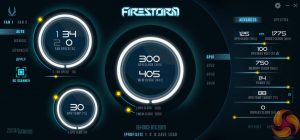
When overclocking the 2070 OC Mini, we used Zotac's FireStorm tool. We were able to add +125MHz to the GPU core, and +750MHz to the memory with the power and temperature target sliders maximised.
3DMark and games testing
I was pretty pleased with this overclock as I wasn't sure how much the card could take given its physical limitations. We saw our Fire Strike score increase by almost 7%, while Shadow of the Tomb Raider reported an increase of almost 6FPS on average when playing at 1440p.Here, we take a further look at the impact of our overclock, looking at the increased temperatures, acoustics, power draw, and lastly, the effect had on the average clock speed.
Temperatures
Acoustics
Power consumption
Average clock speed under load
Overview
The Zotac did surprisingly quite well with this overclock. The GPU temperature rose 4C, up to 67C which is still a good result, though noise levels started to approach 44dB which is getting slightly more bothersome on the ears. Power consumption isn't anything to worry about though, with an increase of about 20W to be expected.
Average frequency did well, too, getting just below the 1900MHz mark. For a card this small, I was quite happy with that – even if other, bigger 2070 cards can run faster out of the box.Having reviewed a number of RTX 2070 cards – all generally quite large and quite fast, I was very interested to get my hands on the Zotac RTX 2070 OC Mini.
We've seen a number of these Mini cards from Zotac in the past, but this is our first look at an RTX 20-series chip that has received the ‘Mini treatment', and I have to say Zotac has done a very good job.
That's because the card actually runs very cool considering its diminutive size, with a peak of just 63C on the GPU core. Power consumption is also the lowest we have seen from an RTX 2070, so that could also be a factor for some.
Zotac was able to achieve such impressive thermal performance in two main ways. Firstly, while I wouldn't categorise the card as ‘loud', it is certainly more audible than full-size RTX cards we have seen over the past couple of months – so you would have to be willing to settle for something not as easy on the ears if you went for a Mini.
On top of that, the Zotac 2070 OC Mini can't run quite as fast as its full-size brethren. It is by no means a slouch, but if we look back at our game performance figures, it is typically 2-3 frames per second slower than the next RTX 2070 card on the chart at 1080p and 1440p resolutions. This was the case whether we were playing titles like Deus Ex: Mankind Divided, or playing Battlefield V with DXR turned on.
We were able to make up this performance difference via overclocking, though, as our sample managed an extra 125MHz to the GPU core and 750MHz on the memory. This brought our frame rates pretty much in-line with heavily factory overclocked 2070 cards from the likes of MSI and Palit, at the expense of slightly increased temperatures and noise levels.
So overall, I have to say I am very impressed with what Zotac has done with its RTX 2070 Mini card. If you've got a standard mid-tower desktop it obviously doesn't make much sense, but if you want to bring high fidelity gaming to your living room in a small chassis, or even build a portable ITX rig for LAN events, this will do the job very nicely – the main compromise for me is the acoustics, but even then it is really not that loud.
What I would say, though, is get the RTX 2070 Mini – not the RTX 2070 OC Mini that I have reviewed here. The cards are exactly the same in terms of build, size, cooling – the only difference is the OC model ships with a 30MHz faster core clock out of the box. It is not very much at all, yet it commands an £80 price premium over its marginally slower brother.
For me, £80 for an extra 30MHz is not worth it – the performance difference between the two cards would be next to nothing, and you could easily make up the gap (and then some) via overclocking. So I have to commend Zotac for making an impressively small RTX 2070 graphics card which is all-round very capable, but if you are looking for a card like this, get the reference clocked version and save yourself the extra £80 you would've paid for the OC edition.
You can find the Zotac RTX 2070 OC Mini for £539 on Amazon HERE.
The model I recommend getting, the RTX 2070 Mini (non-OC), can be found on Overclockers UK for £458.99 HERE.
Pros
- Very compact.
- Inoffensive design.
- Impressive thermal performance.
- Overclocked well considering the size.
- Low power draw.
- Only 1x 8-pin PCIe power connector required.
Cons
- Factory OC model is £80 more expensive for just an extra 30MHz.
- You will notice the difference in noise between this and a full-size 2070.
KitGuru says: Zotac has made another impressive little card with its RTX 2070 Mini. It's an all-round solid card for anyone looking to save as much space as possible – just make sure to go for the reference clocked model instead and save the £80.
 KitGuru KitGuru.net – Tech News | Hardware News | Hardware Reviews | IOS | Mobile | Gaming | Graphics Cards
KitGuru KitGuru.net – Tech News | Hardware News | Hardware Reviews | IOS | Mobile | Gaming | Graphics Cards




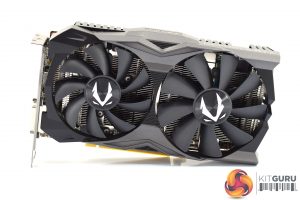

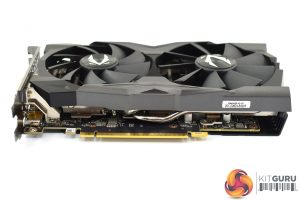
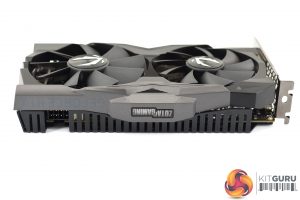





























 n
n














